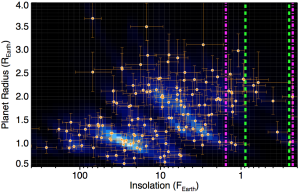
The radii of planets found in the Kepler dataset by Dressing & Charbonneau (2015) as a function of the amount of star light (insolation) they receive. The pink and green lines show ranges of insolation we think might allow the planets to be habitable.
In journal club today, we discussed a recent study by Dressing & Charbonneau (2015) that used the Kepler dataset to search for possibly habitable planets around small (M-dwarf) stars.
Dressing and Charbonneau applied a sophisticated and comprehensive search scheme to look for habitable planets and estimate how effective their search was in finding such planets. Based on their analysis, they estimated that about 1 in 4 M-dwarf stars have planets about the size of Earth in their habitable zones and that the nearest such planet is about 8.5 light years away.
This is far enough that we’d probably still need a generation ship to reach it but a lot closer than one case, 20 light years to the nearest habitable planet, considered by Hein et al. (2012) in their analysis of interstellar colonization. This reduction in travel time could reduce the minimum population required to make the trip from maybe 7,000 to 4,000 people.
Of course, the habitable planet sought in such a trip would orbit a much cooler, redder star than the Sun, so the colonists should be prepared to plant very different crops than we have on Earth.
Attendees of today’s journal club included Simon Pintar, Nathan Grigsby, Jacob Sabin, Tyler Wade, Liz Kandziolka, Jennifer Briggs, and Emily Jensen.

